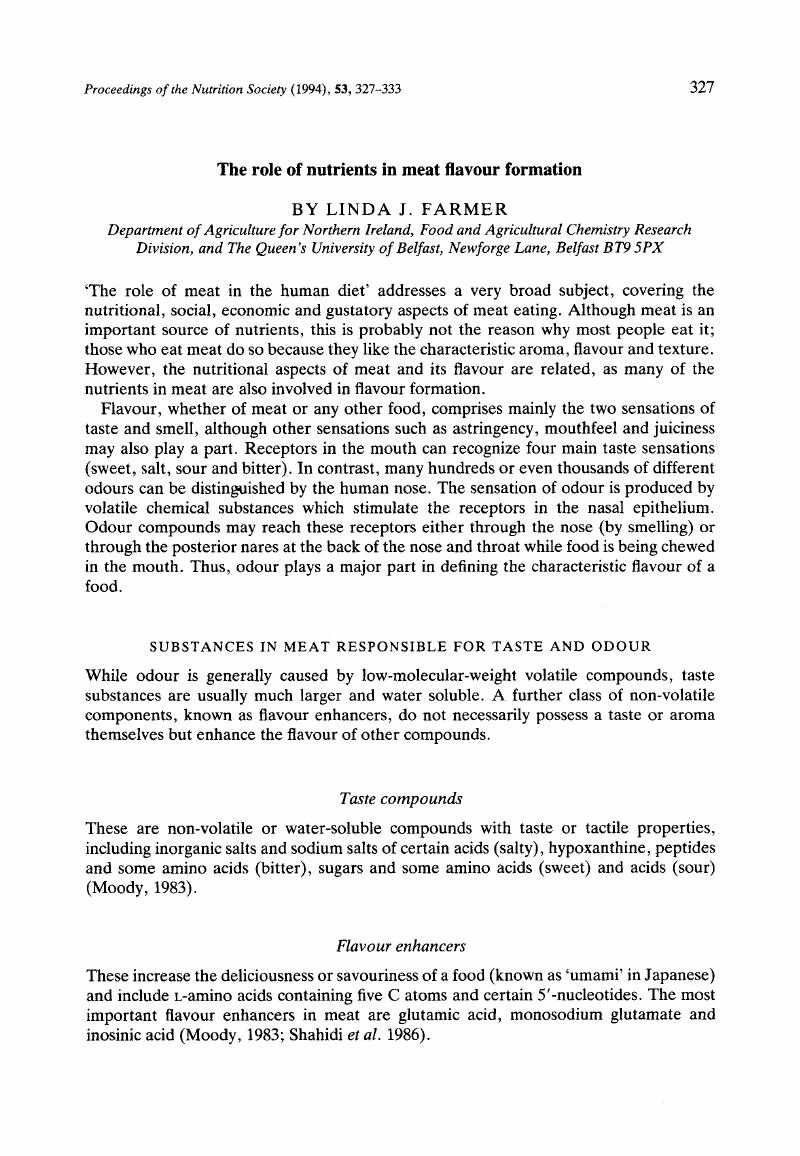Crossref Citations
This article has been cited by the following publications. This list is generated based on data provided by Crossref.
Southgate, D. A. T.
1997.
Production and Processing of Healthy Meat, Poultry and Fish Products.
p.
1.
Fiems, L.O.
Campeneere, S.De
De Smet, S.
Van de Voorde, G.
Vanacker, J.M.
and
Boucqué, Ch.V.
2000.
Relationship between fat depots in carcasses of beef bulls and effect on meat colour and tenderness.
Meat Science,
Vol. 56,
Issue. 1,
p.
41.
Sasaki, Keisuke
Motoyama, Michiyo
and
Mitsumoto, Mitsuru
2007.
Changes in the amounts of water-soluble umami-related substances in porcine longissimus and biceps femoris muscles during moist heat cooking.
Meat Science,
Vol. 77,
Issue. 2,
p.
167.
Imanari, M.
Kadowaki, M.
and
Fujimura, S.
2007.
Regulation of taste-active components of meat by dietary leucine.
British Poultry Science,
Vol. 48,
Issue. 2,
p.
167.
Breer, H.
2008.
The Sense of Smell.
Annals of the New York Academy of Sciences,
Vol. 1126,
Issue. 1,
p.
1.
Hayes, Jenny
2008.
Handbook of Processed Meats and Poultry Analysis.
p.
399.
Wong, Kam Huey
Abdul Aziz, Suraini
and
Mohamed, Suhaila
2008.
Sensory aroma from Maillard reaction of individual and combinations of amino acids with glucose in acidic conditions.
International Journal of Food Science & Technology,
Vol. 43,
Issue. 9,
p.
1512.
Stelzleni, A.M.
and
Johnson, D.D.
2008.
Effect of days on concentrate feed on sensory off-flavor score, off-flavor descriptor and fatty acid profiles for selected muscles from cull beef cows.
Meat Science,
Vol. 79,
Issue. 2,
p.
382.
Schreurs, N.M.
Lane, G.A.
Tavendale, M.H.
Barry, T.N.
and
McNabb, W.C.
2008.
Pastoral flavour in meat products from ruminants fed fresh forages and its amelioration by forage condensed tannins.
Animal Feed Science and Technology,
Vol. 146,
Issue. 3-4,
p.
193.
Piasentier, E.
Bovolenta, S.
Moioli, B.
Orrù, L.
Valusso, R.
and
Corazzin, M.
2009.
Fatty acid composition and sensory properties of Italian Simmental beef as affected by gene frequency of Montbéliarde origin.
Meat Science,
Vol. 83,
Issue. 3,
p.
543.
Boyacioglu, Dilek
Nilufer, Dilara
and
Capanoglu, Esra
2009.
Advances in Food Biochemistry.
p.
291.
Stelzleni, A.M.
and
Johnson, D.D.
2010.
Benchmarking sensory off-flavor score, off-flavor descriptor and fatty acid profiles for muscles from commercially available beef and dairy cull cow carcasses.
Livestock Science,
Vol. 131,
Issue. 1,
p.
31.
Martínez, A.
Aldai, N.
Celaya, R.
and
Osoro, K.
2010.
Effect of breed body size and the muscular hypertrophy gene in the production and carcass traits of concentrate-finished yearling bulls1.
Journal of Animal Science,
Vol. 88,
Issue. 4,
p.
1229.
Sekhon, R.K.
Schilling, M.W.
Phillips, T.W.
Aikins, R.M.J.
Hasan, M.M.
Nannapaneni, R.
and
Mikel, W.B.
2010.
Effects of Carbon Dioxide and Ozone Treatments on the Volatile Composition and Sensory Quality of Dry‐Cured Ham.
Journal of Food Science,
Vol. 75,
Issue. 5,
Vetharaniam, I.
Thomson, R.A.
Devine, C.E.
and
Daly, C.C.
2010.
Modelling muscle energy-metabolism in anaerobic muscle.
Meat Science,
Vol. 85,
Issue. 1,
p.
134.
Sekhon, R.K.
Schilling, M.W.
Phillips, T.W.
Aikins, M.J.
Hasan, M.M.
Corzo, A.
and
Mikel, W.B.
2010.
Effects of phosphine and methyl bromide fumigation on the volatile flavor profile and sensory quality of dry cured ham.
Meat Science,
Vol. 86,
Issue. 2,
p.
411.
2010.
Comprehensive Organic Name Reactions and Reagents.
p.
2701.
Sekhon, R.K.
Schilling, M.W.
Phillips, T.W.
Aikins, M.J.
Hasan, M.M.
and
Mikel, W.B.
2010.
Sulfuryl fluoride fumigation effects on the safety, volatile composition, and sensory quality of dry cured ham.
Meat Science,
Vol. 84,
Issue. 3,
p.
505.
Leong, Jasmine
Morel, Patrick C.H.
Purchas, Roger W.
and
Wilkinson, Brian H.P.
2011.
Effects of dietary components including garlic on concentrations of skatole and indole in subcutaneous fat of female pigs.
Meat Science,
Vol. 88,
Issue. 1,
p.
45.
Smulders, Frans
Hofbauer, Peter
and
Geesink, Geert H.
2014.
Meat Inspection and Control in the Slaughterhouse.
p.
399.



